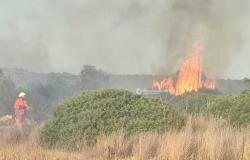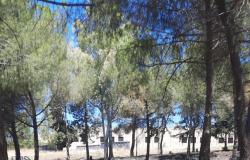Today local politics admits that it is no longer necessary to build, but the already poured concrete will remain to amplify the damage of the next strong storms and more will come
A photo of the flood by Andrea Bernabini published in the book-catalogue of the Ravenna Festival, which we talk about at this link
A year ago the enormous flood occurred which inundated Romagna, including a large part of the province of Ravenna. With heavy rains lasting 48 consecutive hours, 21 rivers flooded between 15 and 17 May 2023, causing widespread flooding in 37 municipalities and around 250 serious landslides. There were 17 deaths, over 20,000 people displaced, many of whom had to throw away everything they had in their homes. The certified damages to the European Union reached 8.5 billion.
But these numbers have the effect of historicizing a past event, while the wounds of the flood are still open and with them the debate on the consequences of the global warming we are experiencing. A debate which, then as now, politics tends to reduce to the exceptional nature of meteorological events, rather than reflecting on the anthropic causes that cause or aggravate these phenomena.
In the days following the flood, the president of Emilia-Romagna Stefano Bonaccini repeatedly blamed the causes on the exceptional amount of rain. That she was undoubtedly the natural person responsible for the event (certainly more than the otters that make their dens along the banks, which some mayors have pointed the finger at), but that is only part of the truth. What local politics did not admit is that the copious water fell on overly waterproofed soil.
Severe thunderstorms, tornadoes and storm surges are treated by the media as occasional events, often with imaginative terms such as “water bombs”; but science agrees that these phenomena are increasingly intense and frequent due to the climate crisis caused by human pollution. Then, when heavy rains hit places covered in concrete, with buildings built too close to waterways and land without trees that can hold back landslides, the disastrous consequences are amplified. Especially if they are also days of rough seas and the rivers are unable to discharge because the waves push from the opposite side, as happened a year ago.
In essence, the flood was the result of the combination of global warming, overbuilding, deforestation and bad governance. Denying it or simplifying the causes favors the tendency to remain immobile and passive, not to correct bad decisions and to continue making worse ones.
The phrase most repeated by Bonaccini in those dramatic days was “we will rebuild everything”, while last March, during a meeting with the mayors of the flooded areas, the governor said that “it will never be possible to build in the flooded territories again”. Appeals and scientific studies have been asking for this for years, but to open the eyes of politics to the climate crisis, the only effective way seems to be catastrophes and deaths. However, in this way we do not act with foresight and prevention, but rather according to an emergency and belated logic. In any case, with respect to these intentions – for now only in words, however during the electoral campaign – one must remain sceptical: on the other hand, in 2017 our region adopted a law defined as “against land consumption”, which is in reality a misleading and self-absolving rule to allow indiscriminate overbuilding to continue. And even if we want to trust this sudden intention to change course, unfortunately it is now too late and a lot of irreversible damage has been done. According to Ispra data, Emilia-Romagna is the third Italian region for land consumption and the province of Ravenna is the third in the region in the three-year period 2020/22, with more than 275 cemented hectares equal to 14.8% of regional consumption . In the ranking of the 20 Italian municipalities with the highest land consumption, 7 are from Emilia-Romagna, including Ravenna in thirteenth position. The concrete already poured will remain to amplify the damage of the next strong storms, and more will arrive due to the building permits now issued for the next few years.
In ancient times, Romagna was a large swamp in which the border between land and water could not be distinguished; a huge wetland area rich in biodiversity, but also poor and unhealthy to live in. The appearance our land has today is a consequence of the reclamations that began in the Middle Ages and continued until the second half of the twentieth century, which generated fertility and economic development. Today we tend to think that it has always been like this, but instead it is a small artificial parenthesis within the geological eras. A parenthesis which, in addition to well-being, has however led to excessive anthropisation: the diverted and concreted rivers cause erosions and floods which we are dealing with, now that the water is once again submerging the Po Valley. This is not the projection of hypothetical maps onto the Adriatic which will touch Bologna in 2100 (and which indeed have the counterproductive effect of pushing the problem away into a future that does not concern us), but rather a phenomenon already underway now.
To date, the Meloni government, despite promising it, has not yet compensated for the furniture and appliances destroyed by the floods, which represent a huge sum. But as the frequency and intensity of extreme weather events increase – which is inevitable even if we were to stop polluting overnight, since climate-changing gases have triggered irreversible processes – the costs will also become increasingly higher and unsustainable. Therefore, in addition to talking about compensation, and instead of thinking that everything will continue as before, we could start planning strategies for adapting and retreating to the advancing sea, of which the flood was one of the manifestations.







